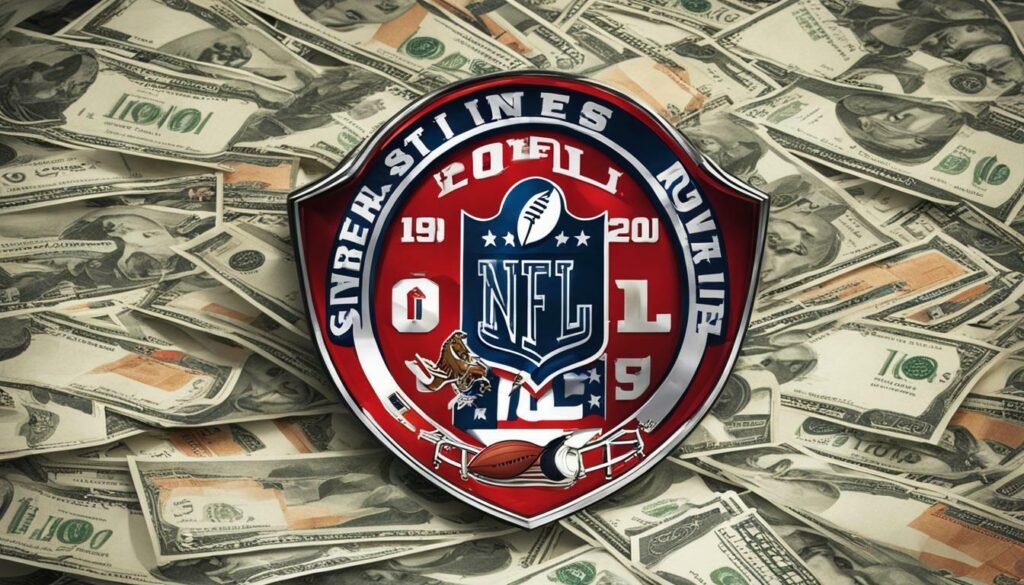The King of Sports: How the National Football League (NFL) Makes Billions in Revenues
How the NFL Makes Money
The NFL, as the most successful American sports league, has established itself as a financial juggernaut, generating billions of dollars in revenue annually. With its massive TV deals and diverse revenue streams, the NFL has solidified its position as the dominant force in the sports industry. From ticket sales to merchandising, licensing rights to corporate sponsorships, the league has mastered the art of generating substantial income.
Key Takeaways:
- The NFL is one of the most successful sports leagues in the United States, earning the majority of its revenue through TV deals.
- Other than from TV deals, revenue streams for the NFL include
- merchandising, ticket sales, licensing, and corporate sponsorships.
- The Green Bay Packers is the only NFL team run as a nonprofit corporation.
- The NFL aims to reach $25 billion in annual revenue by 2027.
- The league categorizes its revenue into national revenue and local revenue.
NFL Revenues
Despite recent controversies and challenges, such as player concussions and protests, the NFL continues to thrive financially. The league’s national revenue for the 2021-2022 season reached an estimated $11.9 billion, inching closer to its goal of $25 billion by 2027. The NFL relinquished its tax-exempt status in 2015, resulting in individual teams shouldering the financial responsibility.
The ownership structure of the NFL is primarily comprised of individual team ownership, with each team functioning as a separate entity. However, one team stands out: the Green Bay Packers. As the only nonprofit corporation in the league, the Packers maintain their unique status while contributing to the overall success of the NFL.
The NFL’s revenue streams are diverse and contribute significantly to its financial prowess. Ticket sales, merchandising, licensing rights, and corporate sponsorships all play a pivotal role in bolstering the league’s revenue. Fans flock to stadiums, generating substantial income through ticket sales and concessions. Additionally, merchandise branded with team logos and licensing rights contribute to the NFL’s financial success.
One of the major pillars of the NFL’s revenue is its TV deals. The league has secured long-term contracts with major broadcasters such as Amazon, CBS, ESPN/ABC, FOX, and NBC, ensuring a consistent flow of revenue. These TV deals are estimated to be worth over $100 billion, highlighting the immense value and popularity of NFL broadcasts.
The NFL’s business model revolves around two main revenue categories: national revenue and local revenue. National revenue encompasses TV deals, merchandising and licensing contracts negotiated by the league, ensuring equal distribution among the 32 teams. Local revenue, on the other hand, comprises ticket sales, concessions, and corporate sponsorships earned by individual teams. This division allows for a balanced financial structure within the league.
Who Owns the National Football League (NFL)?
The National Football League (NFL) is not owned by a single entity. It is owned by the 32 individual team owners. Each team owner has a vote on league matters, and decisions are made by a majority vote. The NFL has a commissioner who is appointed by the owners and is responsible for the day-to-day operations of the league.
The NFL is a privately owned and operated league. It is not traded on a stock exchange. This means that there is no way for the public to own shares in the NFL. However, there are a few ways for investors to get exposure to the NFL, such as by investing in a mutual fund or exchange-traded fund that holds shares in NFL teams.
On a side note, there are some restrictions on who can own an NFL team. For example, corporations, governments, and non-profit organizations are not allowed to own teams. The NFL also requires that a controlling owner hold at least a 30% stake in the team.
One team, the Green Bay Packers, is exempt from these rules. The Packers are owned by the Green Bay Packers Corporation, which is a non-profit organization. The Packers are the only NFL team that is not owned by a single individual or family.
Private Ownership of the NFL Teams
While the Green Bay Packers stand out as a nonprofit corporation, the majority of NFL teams are privately owned. These teams are typically owned by wealthy individuals or ownership groups who invest in the team as a business venture. Private ownership provides owners with control over team operations, decision-making power, and the ability to reap financial benefits from the team’s success.

Private owners have the authority to make important decisions regarding the team’s management, coaching staff, and player personnel. They also have the ability to negotiate sponsorship deals, secure stadium and facility financing, and determine ticket prices. Private ownership allows owners to build and grow their franchises, capitalizing on the popularity and financial success of the NFL.
Ownership Structure and Success
Regardless of the ownership structure, the shared goal among all NFL teams is success both on and off the field. Each team strives to build a winning franchise, attract talented players, and engage fans to drive revenue growth.
One of the stongest mearsures the league uses are payroll rules each team MUST follow which have been designed by the league to strive for balance amoung the teams and players and to achieve an ideal. In brief they are:
- There is a salary cap, which is the maximum amount of money that a team can spend on player salaries. The salary cap for the 2023 season is $224.8 million.
- There is also a salary floor, which is the minimum amount of money that a team must spend on player salaries. The salary floor for the 2023 season is $197.6 million.
- Teams cannot exceed the salary cap or fall below the salary floor. If they do, they will be penalized by the NFL.
The Economics Of How Teams Make Money In The NFL
Each team receives revenue primarily in a few areas. Each of these sources contributes to the league’s multi-billion dollar revenue.
Ticket Sales
Ticket sales play a significant role in generating revenue for NFL teams. With an average stadium capacity of 70,000, games tend to sell out, providing a steady stream of income. The average NFL ticket is priced at approximately $151, generating substantial revenue for teams. However, it’s important to note that ticket sales contribute a smaller portion of revenue compared to TV deals.
Merchandising
Merchandising is another crucial revenue stream for the NFL. By selling officially licensed merchandise, such as jerseys, hats, and memorabilia, the league and its teams generate significant income. The popularity of NFL merchandise among fans further boosts the revenue from this source. The NFL has partnered with companies like Nike and Fanatics to produce and distribute merchandise, ensuring a wide range of high-quality products for fans to purchase.
Licensing Rights
Licensing rights play a vital role in the NFL’s revenue generation. The league grants companies the rights to use its logos, team names, and other intellectual property to produce and sell a variety of products, including apparel, accessories, and collectibles. These licensing agreements enable the NFL to expand its reach and increase its revenue significantly. And each team participates in those revenues in an apportionment.
Corporations’ Sponsorships
Local team Corporate sponsorships form a crucial component of the team’s revenue model. They collaborate with various companies, including those in the tech, gambling, and alcohol industries, to secure sponsorship deals. These companies benefit from the exposure and association with the NFL, while the league receives substantial financial support. The revenue generated through corporate sponsorships helps fund various initiatives and contributes to the overall financial success of the NFL.

“The NFL generates revenue through a variety of streams, including ticket sales, merchandising, licensing rights, and corporate sponsorships.”
NFL TV Revenue – How TV Partners Fuel the NFL’s Financial Success
TV deals play a role in the NFL’s revenue generation, with major TV partners paying substantial amounts for the broadcasting rights to NFL games. These deals contribute significantly to the league’s goal of reaching $25 billion in annual revenue by 2027, as set by NFL Commissioner Roger Goodell.
One of the key TV partners of the NFL is Amazon, which pays a staggering $1.3 billion per year for the rights to Thursday Night Football. CBS and FOX, both major networks, shell out significant amounts as well. CBS pays $1.85 billion annually for Sunday afternoon games, while FOX pays $2.03 billion per year for the same slot. NBC also pays $2 billion per year for Sunday Night Football, and ESPN/ABC pays $2.7 billion annually for Monday Night Football. These TV broadcasters compete fiercely to secure broadcasting rights, given the massive viewership and popularity of NFL games.
Furthermore, the NFL has recently made a groundbreaking multi-year agreement with Google. Starting from the 2023 NFL season, YouTube TV and YouTube Primetime Channels will exclusively distribute NFL Sunday Ticket to consumers in the United States under this agreement. The contract with Google is estimated to pay the league around $2 billion annually, surpassing the previous deal with AT&T’s DirecTV.
These lucrative TV deals not only provide substantial revenue for the NFL but also offer opportunities for exclusive content and attendance opportunities for select YouTube Creators at crucial NFL events.

The NFL generated $18 billion in revenue across the 2022 season, the highest revenue ever recorded in a single year by an American professional sports league.
While TV deals and merchandising/licensing contracts account for the majority of the NFL’s revenue, other revenue streams also contribute to its financial success. Ticket sales, though relatively smaller compared to TV deals, continue to be an important source of revenue for NFL teams. Additionally, concessions at games offer high-profit margins for teams. Corporate sponsorships, including those from tech, gambling, and alcohol companies, also contribute significantly to the league’s revenue.
With its multi-billion dollar TV deals, merchandising and licensing contracts, and diverse revenue streams, the NFL continues to solidify its position as the financial juggernaut of sports.
The Dallas Cowboys: The NFL’s Richest Team
The Dallas Cowboys enjoy the reputation as the NFL’s richest team, with an estimated value of $9.2 billion as of 2023. This iconic franchise, owned by Jerry Jones, has consistently maintained its status as one of the most valuable sports teams in the world.

When it comes to team valuations, the Dallas Cowboys reign supreme. With a staggering worth of $9.2 billion, the Cowboys top the list as the NFL’s richest team. Various factors, including brand value, revenue, and market presence, contribute to their financial standing.
On the other end of the spectrum, there are teams with lower valuations. While the exact figures may vary, the NFL teams with the lowest valuation represents the other end of the financial spectrum. Factors such as market size, team performance, and stadium conditions can contribute to their lower worth. Experts including Forbes report The Bills are ranked as one of the league’s least valuable team, at $2.27 billion.
What NFL Team is worth the least?
While the NFL is home to several highly valuable teams, there is also a team with the lowest valuation, reflecting various factors that influence its financial standing. Among the 32 teams in the NFL, the Detroit Lions currently hold the distinction of being the team with the lowest valuation. According to Forbes’ annual list of NFL team valuations, the Detroit Lions are estimated to be worth $2.5 billion as of 2023. This valuation takes into account factors such as revenue, profitability, market size, and team performance. The Detroit Lions have faced challenges both on and off the field in recent years, which can impact their overall value. On-field success plays a significant role in determining a team’s value, as winning teams tend to attract more fans and generate higher revenue through ticket sales, merchandise, and corporate sponsorships. It is worth noting that while the Detroit Lions may have the lowest valuation among NFL teams, they are still a profitable franchise within the league. The team continues to generate revenue through various streams, including national TV deals, ticket sales, and merchandise. Overall, the valuation of NFL teams is a dynamic and ever-changing aspect of the league. Factors such as team performance, market size, and stadium infrastructure can greatly impact a team’s financial standing. Despite being the team with the lowest valuation, the Detroit Lions are still an integral part of the NFL and contribute to the league’s overall success.

NFL TV Revenue – A Lucrative Source of Income
The NFL has secured massive TV deals, making it one of the most-watched sports leagues in the United States. Broadcasters such as CBS, FOX, NBC, ESPN/ABC, and Amazon have invested billions of dollars for the rights to broadcast NFL games. These TV partners pay substantial annual fees:
| NFL Package | Partner | Annual Cost |
|---|---|---|
| Thursday Night Football | Amazon | $1.3 billion |
| Sunday afternoon | CBS | $1.85 billion |
| Sunday afternoon | FOX | $2.03 billion |
| Sunday Night Football | NBC | $2 billion |
| Monday Night Football | ESPN/ABC | $2.7 billion |
| NFL Sunday Ticket | YouTube TV | $2 billion |
The Business Model and teams participation
The NFL’s business model centers around primary 2 revenue categories: national revenue and local revenue. National revenue is generated through TV deals, licensing contracts and merchandising, which are negotiated at the national level by the league. The moneys are divided equally among the teams (32), without regard to individual team performance. Local revenue, on the other hand, is earned by the teams themselves through ticket sales, concessions, and corporate sponsors.
According to the NFL, in 2022, the league made an estimated $11.9 billion in national revenue, with each team receiving $374.4 million. This includes revenue from media rights, league sponsorships, merchandise, and licensing. The Green Bay Packers, as a publicly-owned team, released figures showing that they earned $235.9 million in local revenue in 2022, which was a slight increase from the previous year.
One notable aspect of the NFL’s business model is the distribution of revenue. National revenue, which is divided equally among teams, provides stability and ensures that all teams have a baseline income. Meanwhile, local revenue offers teams the opportunity to generate additional income based on their market size, fanbase, and business strategies.
National Revenue
National revenue in the NFL consists of revenue generated through TV deals, merchandising, and licensing contracts negotiated at the national level. TV deals are the largest contributor to national revenue and are secured through multi-year contracts with major broadcasters and streaming platforms.
The NFL has contracts with Amazon, NBC, ESPN(ABC), FOX, and CBS, through the 2033 season. These deals are estimated to be worth more than $100 billion in total. The agreements grant the networks the rights to broadcast preseason, regular season, and playoff games, including the highly popular Super Bowl.
Also, the league recently entered into agreements with Google, via YouTube TV and Primetime Channels exclusive rights to distribute NFL Sunday Ticket to consumers in the United States beginning with the 2023 NFL season. This venture is estimated to benefit the league annually approximately $2 billion dollars.
Merchandising and licensing contracts are also a significant source of national revenue for the NFL. The league partners with companies like Nike and Fanatics to sell NFL-branded merchandise. These partnerships help generate additional revenue through the sale of jerseys, apparel, and other licensed products.
Local Revenue
Local revenue in the NFL is generated by individual teams through ticket sales, concessions, and corporate sponsors. This revenue allows teams to capitalize on their specific market and engage with their local fanbase.
Ticket sales contribute to local revenue, although they are relatively small compared to the revenue generated through TV deals. NFL stadiums have an average seating capacity of around 70,000, and games often sell out. However, ticket prices and stadium capacity limit the growth potential of this revenue stream.
Concessions at NFL games, on the other hand, provide a higher profit margin for teams. While they contribute relatively small amounts to overall revenue, the high margins on food and beverage sales make concessions a valuable source of income.
Corporate sponsorships are another important component of local revenue for NFL teams. By partnering with local and national brands, teams can secure sponsorship deals that provide financial support and additional exposure. Corporate sponsors often receive advertising opportunities during games, as well as access to team logos and branding rights.
This also helps Youth Football programs in the extended area nearest an NFL team to garner further interest in the game encouraging everyone from those who want to be a football players girlfriend to extended friends, family, classmates, etc.
It’s important to note that while the NFL generates significant revenue, the league also has high operating expenses. These expenses include player salaries, stadium upkeep, marketing, and administrative costs. However, with careful management and effective revenue generation, teams can maintain profitability and contribute to the financial success of the league.

The NFL’s impressive revenue generation and robust business model position it as the indisputable king of sports, with promising prospects for future growth.
The National Football League (NFL) has established itself as one of the most successful sports leagues in the United States, generating billions of dollars in revenue each year. With a strong emphasis on TV deals, ticket sales, merchandising, and licensing rights, the NFL has built a financial juggernaut that continues to thrive despite challenges and controversies.
The Economics of how teams make money in the NFL
The financial success of NFL teams is not solely dependent on TV deals. Teams also generate revenue through various means, including ticket sales, merchandising, licensing rights, and corporate sponsorships. While TV revenue is the largest contributor, these additional revenue streams play a significant role in bolstering teams’ financial standings. The Green Bay Packers, unique among NFL teams, operate as a nonprofit corporation, highlighting the diverse ownership structures within the league.
The NFL’s business model: national and local revenue
The NFL follows a unique business model that categorizes its revenue into national and local streams. National revenue consists of TV deals, merchandising, and licensing contracts negotiated at the league level. This revenue is divided equally among all 32 teams, regardless of individual performance. Local revenue, on the other hand, is earned by teams through ticket sales, concessions, and corporate sponsorships. This division allows for a balanced distribution of earnings, ensuring both league-wide stability and individual team prosperity.
In conclusion
The NFL’s impressive revenue growth and robust business model have solidified its position as the king of sports. With its extensive TV deals, diverse revenue streams, and strategic partnerships, the league continues to generate substantial income and shows promising prospects for future financial success. Despite challenges and controversies, the NFL remains a financial powerhouse and a cornerstone of American sports culture.
FAQ
Q: How does the NFL generate revenue?
A: The NFL generates revenue primarily through TV deals, merchandising and licensing contracts, ticket sales, and corporate sponsorships.
Q: How much revenue does the NFL make?
A: $11.9 billion in national income was the estimate during the 2021-2022 season. The league aims to reach $25 billion in annual revenue by 2027.
Q: What are the main sources of revenue for the NFL?
A: The main sources of revenue for the NFL are TV deals, which accounted for the majority of national revenue, as well as merchandising and licensing contracts, ticket sales, and corporate sponsorships.
Q: How much do NFL teams receive from national revenue?
A: Each NFL team received $374.4 million from national media rights, league sponsorships, merchandising, and licensing in the past year.
Q: Who owns the NFL?
A: The NFL is owned by its 32-member teams, with the exception of the Green Bay Packers, which is run as a nonprofit corporation.
Q: How much do TV partners pay for NFL games?
A: TV partners, such as CBS, FOX, NBC, ESPN/ABC, and Amazon, pay billions of dollars annually for the broadcasting rights to NFL games. The deals could be worth more than $100 billion in total.
Q: Which NFL team is worth the most?
A: The Dallas Cowboys are estimated to be the NFL’s most valuable team, with a price tag of $9.2 billion as of 2023.
Q: How does the NFL distribute its revenue among teams?
A: The NFL divides its revenue into national revenue and local revenue. National revenue, such as TV deals, is divided equally among the 32 teams, while local revenue, such as ticket sales and concessions, is earned by the teams themselves.
Q: How does the NFL plan to increase its revenue?
A: The NFL plans to increase its revenue through renegotiating TV rights deals, securing a new labor deal, exploring international live-streaming game rights, potentially forming its own mobile network, and expanding its fantasy game.
Q: What is the future outlook for the NFL’s revenue growth?
A: Despite challenges and controversies, the NFL continues to experience financial success and aims to reach $25 billion in annual revenue by 2027.






3 Comments